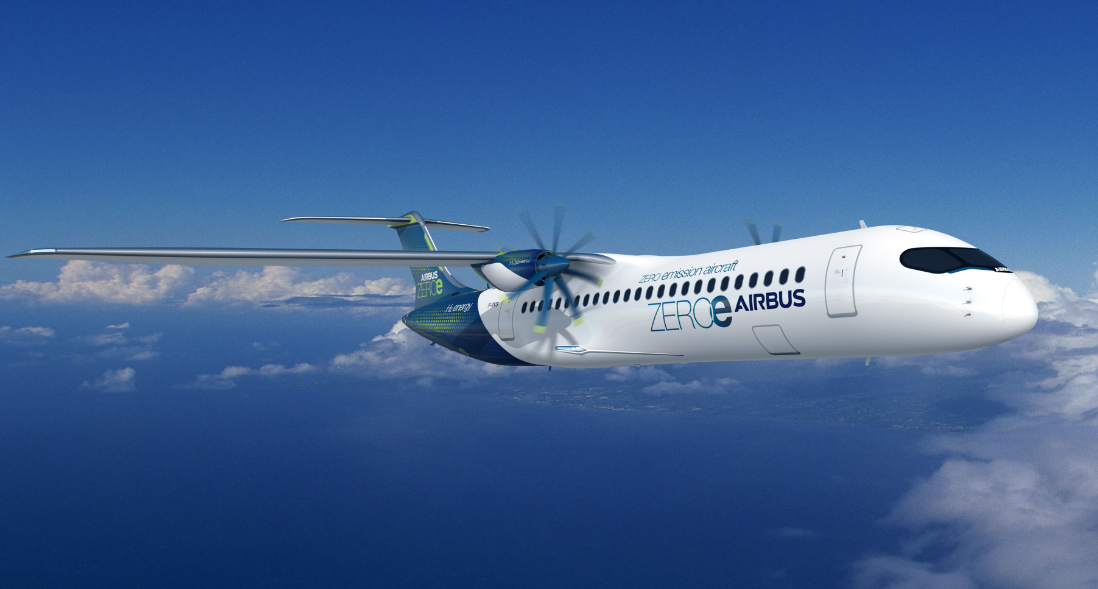
ATR is pursuing hydrogen propulsion as the most feasible path to substantially reducing the carbon emissions of its regional aircraft.
The Airbus/Leonardo partnership is targeting a CO2 reduction of at least 30% from around 2026 onwards.
Airbus has already committed to have a zero-emission airliner on the market by 2035. A short-haul turboprop with up to 100 seats and 1,000 nm range is one of three liquid-hydrogen-fueled concepts being studied by the European airframer.
The decision to pursue hydrogen as a route to lower emissions follows a detailed evaluation of the options, Stephane Viala, ATR SVP of engineering, told an ICAO online conference in September.
“One of the things we have to look at when we talk about moving to the next step is taking an end-to-end approach. We have to look at well-to-tank and tank-to-wake in terms of CO2 emissions,” Viala told the ICAO Virtual Stocking Seminar.
Well-to-tank covers emissions from the production and distribution of energy. “With a battery you have CO2 emissions of 133 grams per kWh per cycle based on the fact that, today, the battery has to be changed every 2,000 cycles. So we have well-to-tank emissions we have to pay for even if we are driven by a battery,” Viala said.
The well-to-tank CO2 emissions for liquid hydrogen are 15 grams/kWh if the hydrogen is green, which means it is produced by electrolysis of water using renewable electricity, but only 2% of hydrogen produced today is green, he noted. Grey hydrogen produced from fossil sources is 463 grams/kWh well-to-tank, compared with 54 grams/kWh for kerosene.
But looking at tank-to-wake CO2 emissions generated in flight, kerosene effectively produces 265 grams/kWh, Viala said, versus zero for batteries—if they are recharged using renewable energy—and zero for hydrogen. Energy cost is also a consideration, however, and, at $0.07/kWh, kerosene is significantly cheaper than electricity at $0.12 and hydrogen at $0.39.
“The overall analysis shows hydrogen is a good path to follow,” Viala said. Fully electric propulsion is not feasible because of the low energy density of batteries, while hybrid-electric based on batteries will not meet the target minimum CO2 reduction, he said.
“So what we are following today is hydrogen,” Viala said. “[But] hydrogen is very expensive,” he noted. “This is where we have to solve the problem ... the only feasible path is hydrogen.”
There are three possible ways of using hydrogen in ATR’s aircraft, Viala said: direct combustion in modified turbine engines; generating electricity in fuel cells; or in the production of drop-in sustainable aviation fuels via power-to-liquid processes.
“We know hydrogen combustion is achievable,” he said, pointing to Russia’s Tupolev Tu-155 testbed, a modified Tu-154 trijet airliner that flew on liquid hydrogen in 1988.
Electric motor and inverter technology is starting to mature and, with an efficiency of around 50%, fuel cells offer an advantage over turbine engines, Viala said. He also raised the possibility of hybridization, possibly by augmenting a hydrogen-fueled turboprop with a fuel-cell-driven electric motor.
U.S. startup Universal Hydrogen, led by former Airbus chief technology officer Paul Eremenko, is developing a hydrogen fuel-cell propulsion conversion for regional turboprops, beginning with the De Havilland Canada Dash 8-300, but also targeting the ATR 42. Market entry is planned for 2024.
“We have also engaged with ATR, which is starting to think about hydrogen, and it has been supportive of the effort,” Eremenko told Aviation Week in August. “Ultimately we think the ATR 72 and the [Dash 8-400] are also addressable.”
The road to sustainable aviation will require simultaneous development of both hydrogen-powered aircraft and the ground infrastructure necessary for successful entry into service, Viala said. That infrastructure is also needed to scale up production of hydrogen for use in low-carbon synthetic fuels that can help bridge the gap to aircraft using a new type of energy, he said.
ATR believes the regional sector is a “natural contributor” to decarbonized aviation, Valia said, because the modest power and range requirements of regional aircraft will enable technical, economic and operational validation to be performed on hydrogen-based aircraft above 50 seats.






Comments